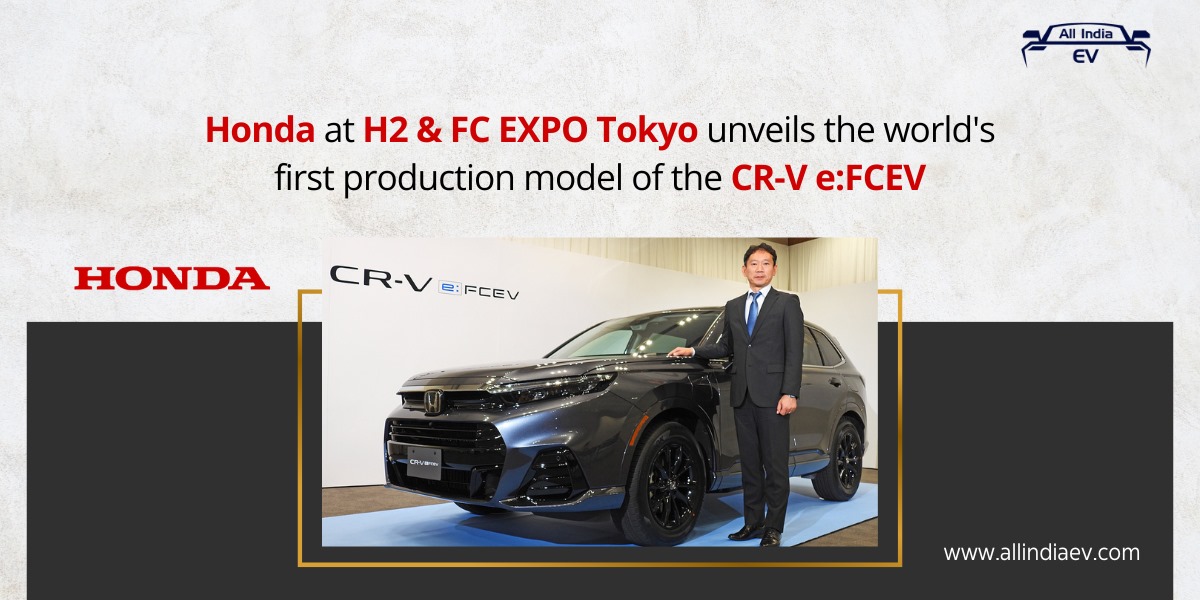Honda Debuts “CR-V e:FCEV” Production Model at H2 & FC EXPO in Tokyo
Honda Motor Co., Ltd. proudly introduced the CR-V e: FCEV, marking a significant milestone with the global debut of its innovative hydrogen fuel cell electric vehicle (FCEV). This cutting-edge model is set to hit the Japanese market in the upcoming summer, symbolizing a notable advancement in clean energy-driven transportation.
Premier Exhibition at H2 & FC EXPO
The unveiling took place at the prestigious H2 & FC EXPO, the 21st International Hydrogen & Fuel Cell Expo, from February 28 to March 1, 2024, at Tokyo Big Sight, Japan. This event served as the perfect backdrop for introducing such a revolutionary vehicle, emphasizing Honda’s commitment to sustainable mobility solutions.
Innovating with a Plug-in Feature
A standout feature of the CR-V e:FCEV is its pioneering plug-in charging capability, a first among Japanese automakers. This functionality allows for charging the vehicle’s onboard battery from an external power source, enhancing the traditional benefits of FCEVs like long driving range and quick hydrogen refuelling times. With this innovation, Honda aims to elevate the convenience and appeal of fuel cell vehicles for everyday use.
Exceptional Range and Versatility
The CR-V e:FCEV promises an impressive driving range exceeding 600km (372 miles) on a full tank of hydrogen, complemented by an additional battery-powered EV range of over 60km (37 miles), as per the Worldwide Harmonized Light Vehicle Test Procedure (WLTP). Based on the 6th generation CR-V, known for its utility and appeal in major markets like North America and China, this model is designed to meet the varied needs of consumers seeking the unique benefits of an SUV.
Collaboration and Production
The vehicle boasts a fuel cell system jointly developed with General Motors (GM), produced by the collaborative venture, Fuel Cell System Manufacturing, LLC, in Michigan, U.S.A. Manufacturing will take place at Honda’s Performance Manufacturing Center in Ohio, U.S.A., with plans to export to Japan and later expand sales to North America within 2024.
Honda’s Vision for a Sustainable Future
Honda’s ambitious goal of achieving carbon neutrality by 2050 for all products and corporate activities is underpinned by a focus on “carbon neutrality,” “clean energy,” and “resource circulation.” Hydrogen is considered a key energy carrier alongside electricity, reflecting over 30 years of Honda’s dedication to hydrogen technology development, starting with the pioneering Honda FCX in 2002.
Key Features of the CR-V e:FCEV
E-Life Generator Concept
The CR-V e:FCEV merges the robustness and functionality of an SUV with the quick refuelling and environmental benefits of hydrogen power, enhanced by the convenience of plug-in charging. It also offers significant external power output capabilities for a wide range of uses, from everyday needs to emergencies.
Innovative Packaging
The vehicle features a spacious cabin and clever cargo space design, utilizing the hydrogen tank’s shape to create a two-level storage area, maximizing utility and organization.
Dynamic Design
The CR-V e:FCEV carries forward the sporty and functional design of its predecessors, with an exterior that conveys a clean, tough, and iconic look unique to FCEVs. The interior, featuring environmentally-responsible materials, maintains the CR-V’s quality while introducing a style distinct to eco-friendly vehicles.
Advanced Fuel Cell System
Enhanced in collaboration with GM, the new fuel cell system offers significant improvements in cost, durability, and performance over previous models, contributing to a superior driving experience.
Versatile Charging and Power Output
Adopting the SAE J1772 standard for AC charging/output, the CR-V e:FCEV facilitates easy household charging and external AC electricity output up to 1500W. Additionally, a DC output connector based on the CHAdeMO standard allows for high-output external power, showcasing the vehicle’s adaptability as a power source for various situations.
Honda’s CR-V e:FCEV represents a bold step forward in the journey towards sustainable, hydrogen-powered mobility, combining technological innovation with the practicality and appeal of an SUV.





